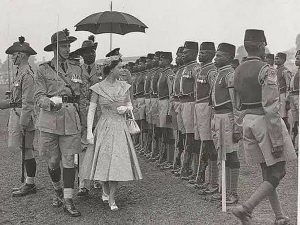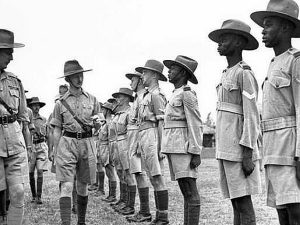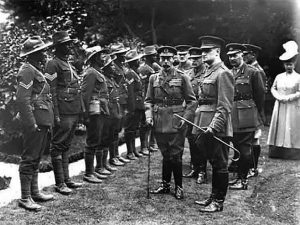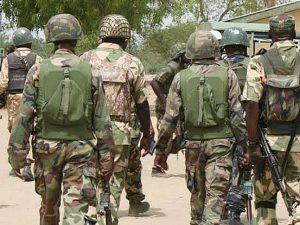History of the nigerian army: The Army, Navy, and Air Force make up the Nigerian Armed Forces as a whole. The Nigerian Army was the Nigerian Armed Forces’ first branch. Its origins may be seen in the several troops the British established in the second half of the nineteenth century to rule the region of west Africa that is now known as Nigeria. The British colonialists raised the troops out of necessity and urgency in order to establish political authority over Nigeria in order to facilitate economic exploitation. An unbiased history of the Nigerian army is provided in this article.

Recommended: Salary Structure of the Nigerian Army
Origin/Founding of the Nigerian Army
Three military organisations from the nineteenth century are where the Nigerian army got its start. The Nigerian Army’s founding is credited to Captain John Glover of the Royal Navy, who chose 18 natives from the country’s north and assembled them into a local force known as the “Glover Hausas” in 1863. Glover utilised the small army while serving as governor of Lagos to undertake retaliatory expedition in the hinterland of Lagos and to defend British commercial routes via Lagos. The “Glover Hausa” became the “Hausa Constabulary” in 1865, becoming a formal police unit. It carried out military and police functions for the Lagos colonial administration. The name “Lagos Constabulary” was afterwards added.

When the Glover’s Hausas were sent to the Gold Coast during the Asante expedition of 1873–1874, their duty was enlarged to include imperial defence. In 1879, this organisation was expanded and given the formal name Hausa Constabulary. Until 1895, when an autonomous Hausa Force was created from the constabulary and assigned only military responsibilities. In Ghana and Nigeria, where it remained into the 1950s, the use of Hausa as the dominant language of command was sustained by this demographic recruiting basis. The ethnic disparity that still exists in the Nigerian military services was also underlined by this event as its historical beginning. The Hausa Constabulary became the “Lagos Battalion” upon joining the West Africa Frontier Force (WAFF) in 1901.
Also see: Funniest Cartoon Movies to watch
The Royal Niger Company (RNC), the Northern Nigerian Constabulary Force in 1886, and the Oil Rivers irregular were also incorporated by the British Government in addition to the Hausa Constabulary. The Niger Coast Constabulary was founded in 1891–1892, renamed the Oil Rivers Irregulars in 1892, and served as the foundation for the WAFF’s Southern Nigeria Regiment. In 1888, the Royal Niger Company Constabulary was established to safeguard British interests in Northern Nigeria. Later on, it served as the foundation for the WAFF’s Northern Nigeria Regiment.
In Jebba, Northern Nigeria, Lord Fredrick Lugard organised the nascent West Africa Frontier Force (WAFF), which would be named in 1890. The Royal Niger Company (RNC) Constabulary’s Northern Nigeria-based components were added to the newly formed force. Under the direction of Colonel Frederick (later Lord) Lugard, WAFF was established in 1897 to fend against French incursions from the north. It truly earned the moniker “WAFF” by the end of 1901 when it unified the paramilitary groups in the other British possessions under its direction. The Nigeria and Gold Coast regiments, the Sierra Leone Battalion, and the Gambia Company made up the interterritorial WAFF by 1901. The force was headed by a small group of British army officers and noncommissioned officers who had been seconded to the force. Even though WAFF was a part of the London-based Colonial Office, each regiment was led by an officer who reported directly to the regional colonial governor.

All troops in each of the dependencies were combined into one regiment as a result of the creation of the West Africa Frontier Force (WAFF). The Northern Nigerian Regiment and Southern Nigerian Regiment are the results of the unification in Nigeria. Lt. CHP Carter (1899–1901) and Col. J. Wilcox (1900–1909) served as the first commanders of the Southern Regiments of WAFF, respectively. The two regiments were subsequently employed for expeditions when Lord Lugard annexed Nigeria between 1901 and 1903.
Recommended: Salary Structure of the Nigerian Police Force
Almagamation of the Southern and Northern Protectorate
The Northern and Southern Regiments were united at the merger of Nigeria on January 1, 1914, and the Nigerian Regiments of the WAFF were thus born. The Nigerian Regiment’s (NR) 1st and 2nd Battalions were formed from the Northern Nigerian Regiments, and its 3rd and 4th Battalions from the Southern Nigerian Regiments. These colonial forces served in German East Africa, the Cameroons, and Togoland during the First World War. The WAFF changed its name to the Royal West African Frontier Force in 1928, and the administration of the RWAFF passed from the Colonial Office to the War Office in 1939.
About 3,500 soldiers were a part of the Nigeria Regiment in 1930. Major units were located at Sokoto, Kano, Zaria, Kaduna, Maiduguri, Yola, Enugu, and Calabar during the RWAFF reorganisation of the 1930s, which resulted in the division of the colony into northern and southern commands and the reconfiguration of its four battalions into six. Specialists were primarily hired from the south, despite the fact that Hausa and their language predominated in the infantry and general support groups. For instance, Yoruba were hired for the signals firm since that section needed people who could speak English fluently.
Also see: Most Famous Scientists In The World And Their Discoveries
Nigeria served as the assembly and training location for the two West African divisions sent to Burma during World War II, and Nigerians participated in combat in Kenya as well as the Italian East Africa and Burma operations. Auxiliary units, made up of 630 porters divided into three companies for each infantry brigade, were also established in 1941. The auxiliary were abolished after the war, but some carriers who had been hired locally stayed on the job. A two-brigade army was expanded, and specialised combat and service units including light artillery, communications, signals, medical, engineers, and motor transport were established in the 1950s.
After the Second World War, the Northern Regiments’ Mounted Infantry became the regular Infantry Battalion. The Northern Regiment had a field artillery as well. RWAFF resumed its principal goal of ensuring domestic security in the years following the conflict. To break strikes, to regulate local disturbances, to ensure tax collection, and to support police anticrime operations, Nigerian troops executed police actions and punitive expeditions. In the southern region of British Cameroons, they also launched a significant internal security operation to quell secessionists who were defying colonial rule.
The Nigeria Regiment was renamed the Nigerian Military Forces, or RWAFF, in 1956, and the colonial government of Nigeria assumed control of the force from the War Office in April 1958. The officer corps gradually became more African throughout the 1950s. By the time of independence in 1960, there were eighty-two Nigerian officers, predominantly Igbo from the southeast, having been appointed since the country’s first one in 1948. The officer corps had a greater ethnic balance than the rank and file, where northerners were more prevalent.

Recommended: Best Car Manufacturing Companies In Africa
Visit of Queen Elizabeth of Britain
The Nigerian regiment was renamed the Queens Own Nigerian Regiments (QONR) during Queen Elizabeth’s visit to the country between 28 January and 15 February 1956. The WAFF was regionalized and each military unit became independent of the others in the same year as well. The QONR changed its name to the Nigerian Military Force (NMF) as a result.
By June 1st, 1958, the Nigerian Government had taken over management of the NMF from the British Army Council in London. The NMF changed its name to the Royal Nigerian Army (RNA) in 1960, the year Nigeria gained independence. The RNA became the Nigerian Army after Nigeria became a republic. The Army replaced its RWAFF-era uniform, rank system, and equipment with new ones in the same year, including a green khaki uniform.

Recommended: Most Powerful Intelligence Agencies Of The World 2023
Conclusion
The lengthy history of the army that evolved into the Nigerian Army cannot be adequately covered in a few web pages. We do, however, hope that this article would make contemporary Nigerians more aware of the colonial conquest battles and give credit where credit is due—to our forebears who battled to preserve our independence.

Edeh Samuel Chukwuemeka, ACMC, is a lawyer and a certified mediator/conciliator in Nigeria. He is also a developer with knowledge in various programming languages. Samuel is determined to leverage his skills in technology, SEO, and legal practice to revolutionize the legal profession worldwide by creating web and mobile applications that simplify legal research. Sam is also passionate about educating and providing valuable information to people.